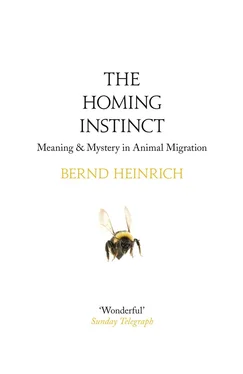Floyd’s family’s home was the farm four hundred meters down our dirt road. It was populated by chickens, geese, cows, pigs, plus all the other usual and unusual wildlife that lives in a place with a tolerance for disorder. Along with Floyd, my companions were the four Adams boys, Butchy, Billy, Jimmy, and Robert, an in-law of theirs. Floyd, a dark-haired, mustachioed, wounded Marine Corps veteran recently returned from the Pacific, had a bad limp and a thirst for Black Label beer. Leona, his blond, petite wife, appreciated his fondness for honey but less so his taste for beer. He and the “boys,” after a hot day haying, sometimes went fishing on our nearby Pease Pond in the evening, but in August our big draw was always the beelining.
After we found a bee tree, we carved our initials into the bark to proclaim ownership (property lines were irrelevant with regard to bee trees; finders keepers was the rule), and at some convenient time we returned with crosscut saw, axes, wedges, a beehive, and pails and kettles for honey. Getting part of our living from the land was fun, and it meant understanding and using the bees’ homing behavior to find their hollow trees in the forest and resettling them into a new home, which we brought back to the farm and set up at a window in the attic of the house.
Fast-forward to a quarter-century later: My nephew Charlie Sewall and I are in a patch of goldenrod blooming in a pasture where each fall the wild honeybees gather nectar to top off their honey stores for the coming winter. We start by capturing a single bee in our bee box, a simple four-sided wooden box that has a ten-by-fifteen-centimeter piece of honeycomb with sugar syrup filling out the bottom. We dab the box with a drop of anise for scent and capture our bee by holding the box under her after she has landed on a flower and then slapping the box cover over her. At first the captive buzzes in the box trying to escape, but the buzzing stops when she stumbles onto the sugar syrup and starts to tank up, which will take her a minute or two. We then remove the cover and set the open box onto a pole that reaches to just above the tips of the goldenrod. We gently daub her with a spot of paint while she is absorbed in sucking up syrup, as I remembered Floyd doing. We then hunker down into the goldenrod and wait as she continues sucking up her newfound sweets that she will soon share with her hive mates. After about two minutes, her honey stomach is filled. She crawls out onto the edge of the box, stops to wipe her antennae with her front feet, lifts off, and flies back and forth downwind of the box. We duck lower to keep her silhouetted in sight against the sky as she starts flying loops, which become increasingly wider and oriented in one direction. Finally she straightens her flight path and takes off, making a “beeline” into the distance. Knowing that nobody in that direction keeps bees, it’s clear that she is on her way to a bee tree. She will soon be back with others, and we then consult our wristwatches to time her trip. A bee flies about four hundred meters a minute, and it may take her three to six minutes in the hive to regurgitate and unload her honey stomach’s contents into the mouths of begging, receiving bees.
We settle down and wait, and after perhaps ten minutes or less a bee suddenly appears and makes very rapid zigzagging flights just downwind of the box. The sound of her fight has a higher pitch than that of the bees foraging on the nearby goldenrod flowers. This means that she is more motivated and has a higher body temperature because of the rich food she is expecting. She settles into the box and starts imbibing the syrup. More bees will come soon, and when they get near our bee box, they will be guided in by the scent of the anise that marks the spot. After they tank up, we watch their flight directions.
If the food is in the immediate home vicinity, the bee does a “round dance” on the honeycomb when she returns to her home. She repeatedly runs in small circles while shaking her abdomen, and she regurgitates small samples of her find at intervals during her dance. If they become motivated after receiving information about the quality and scent of the food advertised, her hive mates leave the hive and search for the advertised food. If it is beyond a few hundred meters, the bee alters her dance to also contain information concerning location. The distance of the journey to the food is proportional to the duration of the waggle runs, and the angle of the straight runs with respect to the vertical direction informs the bees in what direction to fly when they leave the hive. If the straight run is in the up -direction on the honeycombs (which always hang vertically in the hive), the food source is in the direction toward the sun. If the food location is, for example, at an angle of ten degrees to the right of the vertical, the food direction is ten degrees to the right of the horizontal component of the sun direction when the bee would fly from the hive. Thus, her behavior is a symbolic representation in body movements of the flight to the food.
The first steps in the evolution of recruitment likely involved simple alerting signals in or at the nest entrance before takeoff. Other bees could have followed those signaling bees, probably by scent, for at least a short distance in flight. Through a few million years, the alerting likely became modified to take on an ever-greater leading function by bees flying in an ever more conspicuous manner in the direction of the food, so that followers could start off flying with ever greater accuracy in the right direction. These flights, later in the evolutionary progression, were eventually restricted to a buzz run directly on the top of the combs, but still in the food direction. We can infer this, because such “primitive” recruitment is still found in some tropical honeybee species that have their combs in the open air, where this mechanism makes sense. But open-air homes, though convenient for such communication of food location, were vulnerable to predators and also precluded the bees from living in huge areas of the globe, those with cold climates.
Homes in hollow trees allowed the bees to live in areas where they would otherwise be excluded because of cold and/or nest predators. But in such safer homes the combs hung from the roof of a cavity and left no horizontal dancing platform, and additionally the “dance floor” was now in darkness, so bees could not point directly toward the food. Even if they could, they would not be seen. But a breakthrough for indicating horizontal directions on vertical surfaces became possible after some bees started using the hanging flat surfaces of combs as their dancing platform while indicating the sun’s location as the up or “toward” direction in their dance. Additionally, tactile rather than visual orientation became predominant for recruits in reading the code within the nest.
It is amazing enough for an animal to be able to navigate to a location it has never been to before. But some ants do something even more amazing. In North Africa, desert ants live in underground homes where they are protected from the heat. But they must venture out onto the searing surface periodically to forage by scavenging on heat-killed prey. The ants are fast runners that have evolved a very high tolerance for heat. Still, at times it is a matter of life and death even for them to make it back to their cool underground home; they cannot afford to wander on the sand surface for an extended time without access to their shelter to cool down and replenish body fluids. This is where their homing ability comes in; they may have zigzagged in all directions to find a heat-killed insect, but after finding one they must make a straight “ant line” directly back home. This begs the question, Since they are often on a featureless plain and have not kept a steady course, how do they know in what direction to head home?
Читать дальше












